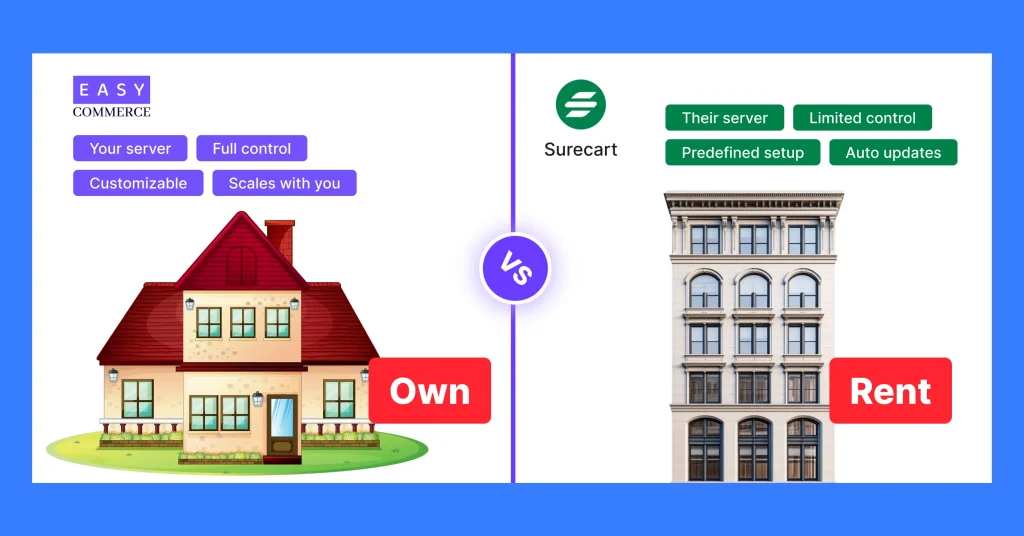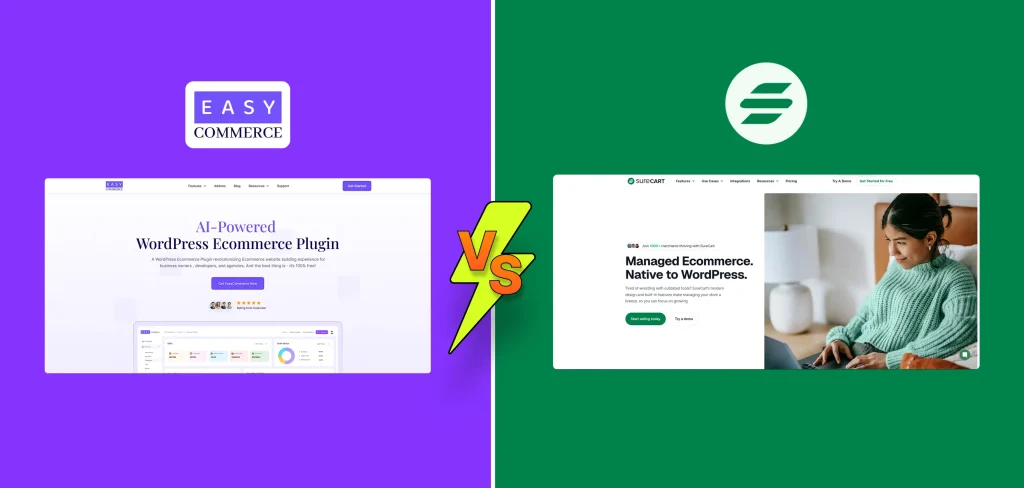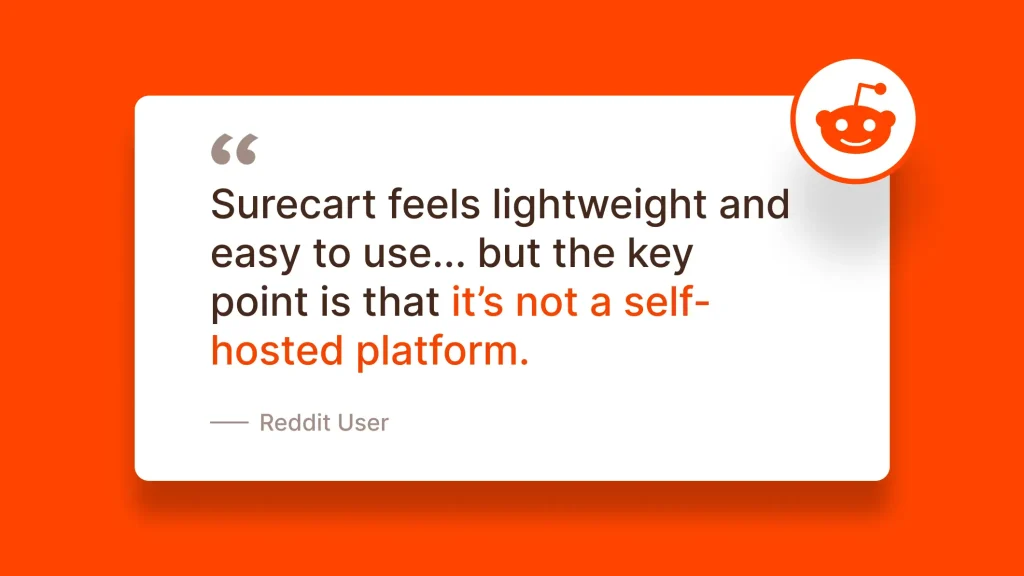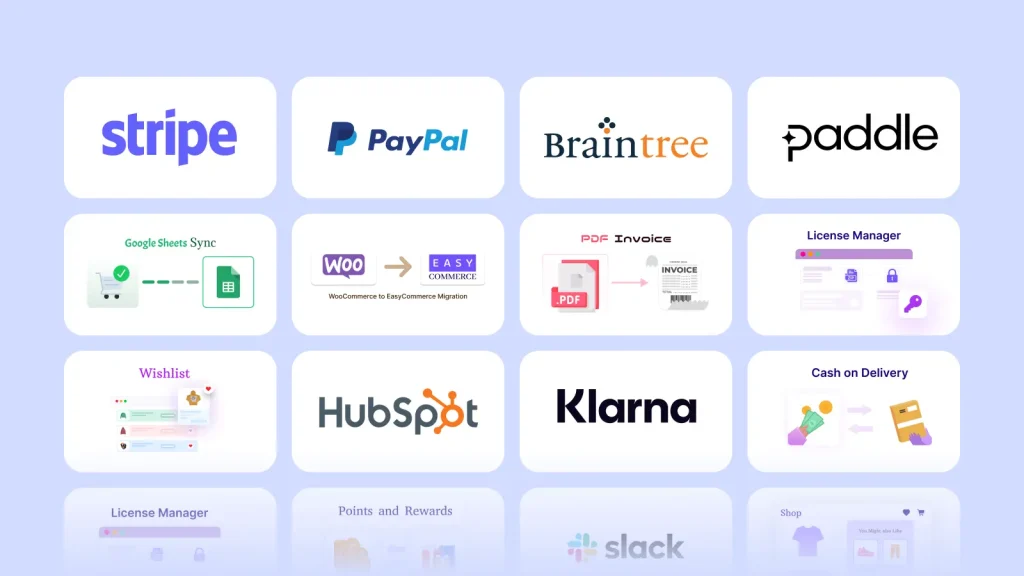WooCommerce may still lead the WordPress ecommerce space, but new players like EasyCommerce and SureCart are making noise with faster, simpler, and smarter setups.
On the surface, both appear similar; you install the plugin, add products, connect payments, and your site becomes a store. But underneath, they work very differently, and that’s what really affects speed, growth, and overall experience.
So which one’s better? There isn’t a one-size-fits-all answer. In this blog, we’ll break down the key differences so you can see how each fits real-world use. Let’s dive in.
The Core Difference: WordPress-Native vs. SaaS Dependency

Here’s a simple analogy:
EasyCommerce is like owning your own house. You control the walls, the roof, the paint, and even the wiring. If you want to knock down a wall and add a new room, you can.
SureCart is like renting an apartment. It’s modern, well-maintained, and often easier to start with. But you can’t just tear down walls or redesign the kitchen without asking the landlord.
That’s the heart of the comparison.
EasyCommerce lives entirely inside WordPress. No external accounts. No server dependency. If your site is live, your store is live.
SureCart is sort of same same but different. You still install a plugin, but much of your store runs on SureCart’s servers. That can feel convenient at first, but it means you’re always tied to their system.
This single choice between WordPress-native or SaaS-powered shapes speed, data, pricing, customization, and even your store’s long-term future.
EasyCommerce vs. SureCart: Comparison Table
| Feature | EasyCommerce (WordPress-native) | SureCart (SaaS-connected) |
| Setup | Install and run inside WP | Requires SaaS account sync |
| Performance | Fast queries with custom tables, API first | API-first, hosted server dependency |
| Customization | Full control, developer-friendly | Customizable but not the core SaaS platform |
| Payments | Multiple gateways, flexible | Limited to the supported list |
| Data Ownership | 100% yours in the WP database | Stored on SureCart servers |
| Scalability | Scales with WordPress freely | Scales on SaaS limits |
| Admin UI | Single-screen product manager | Cloud dashboard + WP link |
| Integrations | Compatible with WP ecosystem | Growing list |
| Pricing | Free + paid addons, predictable | Recurring subscription |
12 EasyCommerce vs. SureCart Factors You Should Know
You might already have a rough idea of how EasyCommerce and SureCart differ, but that’s not enough to call one better than the other. Let’s dig deeper and break down the key factors in detail.
1. Setup and Getting Started
Getting started is the first test of any ecommerce platform. If setup feels like a headache, most people give up before even launching.
With EasyCommerce, it’s straightforward:
- Install the plugin from your dashboard.
- Add your products.
- Set up payments and shipping.
- Start selling.
That’s it. Everything happens inside WordPress, so you don’t juggle accounts or dashboards.
SureCart adds a few more steps:
- Install the plugin.
- Create a SureCart account.
- Connect your WordPress site to their SaaS dashboard.
- Configure everything through that connected system.
That’s not terrible, but it does feel like setting up two platforms instead of one.
Scenario: I know a food blogger who wanted to sell recipe eBooks. With EasyCommerce, she was up and running in about 40 minutes, complete with Stripe payments. She tried SureCart too, but between account creation and syncing products with their dashboard, it stretched into a few hours. For a small business owner juggling multiple tasks, that difference mattered.
2. Speed and Performance

Speed is the silent killer in ecommerce. According to Google (2016 data), 53% of visitors leave a site if it takes longer than 3 seconds to load. Every extra second costs you conversions.
Here’s where the technical differences between EasyCommerce and SureCart show up clearly.
EasyCommerce: It uses your local server space to store products, orders, and customer data. That means your store doesn’t have to dig through the clutter of regular WordPress tables. Product searches, order lookups, and reports run much faster and stay smooth even as your catalog grows.
SureCart: Works through its SaaS API. So whenever your store loads product data or runs checkout, it pings their external servers. If their servers are under load or your internet connection isn’t great, or even for latency, you might notice slower responses.
SureCart’s performance might be fine for smaller digital shops. But if you want to scale into thousands of products, EasyCommerce’s architecture gives you a real edge.
3. Features Out of the Box
Both plugins give you what you need to run a store, but they package it differently.
With EasyCommerce, you get:
- Product management (physical + digital)
- Artificial Intelligence assistance
- Checkout
- Shipping and taxes
- Number of free payment gateways
- Coupons and discounts
- Abandoned cart recovery
- Low stock reminder
Add-ons unlock advanced features, but the basics are found ready right away.
On the other hand, SureCart focuses more heavily on digital-first businesses. It shines with things like:
- Subscription billing
- Checkout optimization (like one-click upsells)
- Digital delivery and memberships
SureCart feels polished for creators, coaches, or subscription businesses. But if you want complex shipping, flexible tax rules, or deep integration with WordPress tools, EasyCommerce offers more ground to build on.
4. Customization and Control
Control is where a lot of people either fall in love with a tool or grow frustrated.
EasyCommerce gives you near-total freedom. Checkout pages can be styled (via checkout editor) to match your site’s theme. Developers can hook into the codebase, do custom changes in the interface and functionality, etc. It feels like part of WordPress, doesn’t it?
SureCart also offers strong customization capabilities. You can visually style every part of the checkout using drag-and-drop blocks and page builder components. It also includes developer-friendly hooks, validation filters, APIs, and webhooks for deeper functionality.
However, because it’s powered by a SaaS infrastructure, you can’t modify its core structure or logic. It also means you’re actually working within the boundaries of their system.
5. Payment and Checkout
Checkout is the make-or-break point of any store. The Baymard Institute stated that nearly 70% of ecommerce carts are abandoned without completing the purchase. That’s a massive number when compared to the overall industry size(US$3.66tn in 2025). And a clunky checkout is one of the top reasons why.
EasyCommerce: Supports multiple gateways, with addons for more(international, regional, and local). The checkout page stays inside your WordPress theme, so it feels seamless. If you want to tweak the design further, you can.
SureCart: Supports the payment gateways they officially integrate with. During checkout, part of the process runs through SureCart’s own servers. This keeps payment handling secure, but it also means your store depends on their system. For some shoppers, the checkout can feel a bit separate from your site.
👉 Scenario: One of our niche electronics store owners tested both. Customers on his SureCart checkout page occasionally asked if the payment page was ‘part of the same site.’ With EasyCommerce, nobody asked that, because everything looked so native.
6. Data Ownership and Privacy

This is a huge one.
With EasyCommerce, all data stays in your WordPress database. Everything belongs to you, including orders, customers, and payments. You can export it, migrate it, or back it up without asking anyone’s permission.
SureCart, being a SaaS-like model, stores data on its servers. While they secure it well, you’re still handing your entire customer database to a third party. If their policies change, or if you need to comply with strict local regulations, you’re tied to their system.
👉 Example: An EU-based retailer needed GDPR compliance that required local storage of customer data. EasyCommerce worked without issue. SureCart wasn’t an option, since data was stored on servers outside their control.
7. Scalability and Growth
Let’s talk about the dream scenario: your store blows up(in a positive way). Suddenly, you’re handling thousands of orders a week. Can the platform keep up?
EasyCommerce was built with ease of scaling in mind. Separate product tables and an API-first approach mean your database doesn’t choke under large catalogs. A few of EasyCommerce’s large-scale users report running 10,000+ SKUs without noticeable slowdowns.
On the other hand, SureCart scales within its infrastructure, which means you’ll need to upgrade the subscription plan to extend the functionality. This might sound good until you realize you can’t control how their scaling works. If they impose limits, you’re stuck.
👉 Scenario: A handmade crafts store started small, with 50 products. As they expanded to 5,000 items, EasyCommerce kept humming. They had tested SureCart, too, but syncing large product batches took longer, and support admitted there were API limits.
Special note: It’s rare for one store to grow from 50 to 5,000 products overnight. However, platforms like SureCart can handle a gradual increase in products and orders to some level. But with EasyCommerce, you can grow freely; no limits, no need to ask.
8. User Experience: Admin and Customer Side
How does it feel to use these platforms every day? Let’s find out:
Admin Side
On the admin side, EasyCommerce works directly inside WordPress. Store owners can add products, track orders, and adjust settings without leaving the dashboard. Everything feels like one system, so there’s less back-and-forth and no extra panels to manage.
SureCart, on the other hand, has a modern SaaS interface. Some users like the design, but others find it disruptive to switch between WordPress and the SureCart panel when managing routine tasks.
Customer Side
On the customer side, EasyCommerce keeps the entire shopping journey inside the store. Checkout pages are generated locally, follow the site’s theme, and create a smooth, familiar flow.
SureCart also offers a clean checkout (be it from the shop page or a direct link), but because it partly runs on their servers, the experience can sometimes feel separate from the main site.

For customers, both offer clean checkout flows. But EasyCommerce blends perfectly into your site’s theme, while SureCart sometimes feels like a layer sitting on top. Most users consider this as no big deal.
9. Addons, Integrations, and Ecosystem

Both EasyCommerce and SureCart have their perks, just in different ways.
EasyCommerce: Plays really well with tons of WordPress plugins. SEO tools, CRMs, Email Marketing, Analytics, you name it. Plus, some handy add-ons come bundled, so you don’t have to go hunting for extra tools. Everything stays inside WordPress, which makes life easier if you like keeping things simple and under one roof.
SureCart: Has its own growing list of integrations. Official connections with Elementor, WP Fusion, Zapier, and more mean you can hook up thousands of apps and automate stuff easily. The catch? Some things happen outside WordPress, so it doesn’t feel as “native” as EasyCommerce.
Bottom line:
- EasyCommerce = perfect if you love WordPress-native control.
- SureCart = great if you want automation and extra app connections.
10. Support and Community

SureCart has already built a large user base. You’ll find YouTube tutorials, Facebook groups, and forums with active discussion. However, official support is likely to be prolonged if you’ren’t a paid customer.
EasyCommerce is a comparatively newer platform, but it has a loyal user group and a growing community. Because the dev team is still close to users, support often feels more personal and responsive. Regardless of whether you’re just a wonderer or a paid bundle customer, each query is answered with the same amount of priority.
It’s the classic trade-off: larger community vs closer, more hands-on support.
11. Future Potential
Both platforms are moving fast, especially SureCart, but using a different approach.
EasyCommerce: Getting cooler by the day. It already has AI that writes product descriptions for you, and features like smart search and product recommendations are on the way. The product page is easier to use now, and addons come bundled, so you don’t need to keep buying extras. Think of it as WordPress eCommerce on turbo mode.
SureCart: Sticking to the SaaS style. Their big win? They roll out an update, and everyone gets it instantly. No setup, no waiting.
The real difference: EasyCommerce is leveling up while still giving you full control of your store. SureCart is growing, too, but you’re kind of stuck inside their system. And honestly, it feels like SureCart is already at its peak. Like most plugins, once better options show up (yep, like EasyCommerce), it’s only a matter of time before the hype slows down.
12. EasyCommerce vs SureCart Cost

When starting a small business from scratch, the upfront cost of creating and maintaining an ecommerce setup matters heavily.
EasyCommerce: Free core plugin. Paid addons or plans for advanced features. Costs are predictable and tied to your site. There are three types of pricing tier: Personal, Professional, and Agency. See the pricing here.
SureCart: SaaS subscription model. Monthly or yearly payments. Over time, the costs add up as the business grows. Want to use the free version? Be ready to share a chunk of your profit with SureCart, as they charge a commission percentage for every transaction in free mode.
👉 Example: A small bakery ran the numbers. EasyCommerce (with addons) costs them under $200/year ($119/year with 40% OFF). SureCart’s SaaS plan for the same needs came to $179/year. For them, EasyCommerce made more sense.
Read our another blog on EasyCommerce vs. WooCommerce.
Final Thoughts: Which One is Better for You?
Both EasyCommerce and SureCart can power a store. Both can help you sell products online. But the experience they offer is very different.
If you value control, speed, flexibility, and data ownership, EasyCommerce is the better fit. It grows with you, scales smoothly, and keeps your business independent.
If you want SaaS simplicity and don’t mind giving up some control, SureCart might feel easier, especially for subscription businesses or digital product creators.
At the end of the day, ask yourself this:
Do you want your eCommerce store to live fully inside WordPress (EasyCommerce), or are you okay with it partly living in the cloud, tied to another company’s system (SureCart)?
For many long-term WordPress users, EasyCommerce is the safer, faster, and more future-proof choice.
Frequently Asked Questions (FAQs)
1. EasyCommerce vs SureCart vs WooCommerce: Which one is better?
WooCommerce falls behind because it’s built on old tech. As stores grow, it slows down, hurts the user experience, and needs too many plugins. It makes it expensive and hard to manage. SureCart and EasyCommerce were made to fix these problems. But between the two, EasyCommerce wins with better speed and more flexibility.
2. Do EasyCommerce and SureCart have extra costs?
Yes. With SureCart, the free plan takes a cut from every sale, and advanced features only unlock on higher-priced plans. Whereas EasyCommerce is free at the core and offers bundled features in one simple plan, without surprise costs.
3. What is the difference between self-hosted and hosted?
A self-hosted platform (like EasyCommerce) keeps all your store data as in products, orders, and customers, on your own WordPress site and server.
On the other hand, a hosted platform (like SureCart) stores your data on its servers. It feels convenient at first, but you’re dependent on their system, pricing, and limits.

